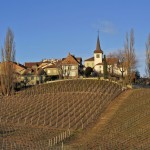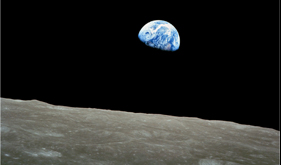Great Photographs No. 4
Earthrise
The crew of Apollo 8
On Christmas Eve 1968 Apollo 8 emerged from behind the Moon on its fourth orbit. Aboard were Commander Frank Borman, Command Module Pilot James Lovell, and Lunar Module Pilot William Anders – the first three men to leave Earth’s gravity and circle another celestial body.
They were taking photographs, thousands of them, but object of their photography was purely practical – capturing high resolution images of the lunar surface on the far side, and scouting out potential landing sites on the near side.
In order that they could take those photographs the spacecraft had been rolled so that its windows pointed directly down towards the lunar surface. And the results show an endless expanse of grey, cratered landscape. It was scientifically interesting, but scenically boring.
Whilst around the far side of the Moon the astronauts had been totally isolated. As they emerged on that fourth orbit Borman rolled the spacecraft so as to position its antennae for radio contact with Mission Control. And, as he did so, he looked out of the window in order to orient himself with the lunar horizon. Then someone spoke …
Borman or Anders: Oh, my God! Look at that picture over there! Here’s the Earth coming up. Wow, is that pretty!
Anders or Borman: Hey, don’t take that, it’s not scheduled. (Chuckle)
Borman: [Laughter] You got a color film, Jim?
Anders: Hand me that roll of color quick, will you…
Lovell: Oh man, that’s great!
The first photograph taken was a black and white image. But which of the crew members took it is a matter of dispute. Borman claims the honour, but in-flight recordings seems to indicate that the photographer was actually Anders.
That first photograph is little-known and rarely seen. This is the one that has seared itself into the public consciousness … the second one, in colour, taken by William Anders. He was working with 70mm colour transparency film, in a Hassleblad camera.
This is the photograph that first showed us the smallness and insignificance of the Earth – a blue and white blob in the vastness of black space. It contrasts the barren, hostile, colourless landscape of the Moon with the dynamic, colourful, life-giving sphere of the Earth. Life magazine named it one of the hundred great photographs of the century and, in the book 100 Photographs that Changed the World, wilderness photographer Galen Rowell calls this image, “… the most influential environmental photograph ever taken.”
Photographing the Earth, rising over the Moon’s horizon was not on the mission schedule. It had nothing to do with science or mapping. It was pure beauty, taken in a moment of luck.
But, out of the thousands of photographs taken on that mission, this is the one that still speaks to us today.
Return to Great Photographs page











What do you think?
(Please note: though your email address is required to control spam, it will not be shown or re-used in any way)
You must be logged in to post a comment.